
Pyotr Andreyevich Kikin (Russian: Пётр Андре́евич Ки́кин; 27 December 1775, Alatyr – 18 May 1834, Saint Petersburg?) was a Russian general and a Secretary of State under Tsar Alexander I.

Pyotr Andreyevich Kikin (Russian: Пётр Андре́евич Ки́кин; 27 December 1775, Alatyr – 18 May 1834, Saint Petersburg?) was a Russian general and a Secretary of State under Tsar Alexander I.
He was one of twelve children born to Major Andrei Kikin (1747-1790) and his wife Maria Yermolova (1754-1819). His baptismal name was Bartholomei, but he never used it. As soon as he was old enough to take some responsibility, he was enrolled in the Guards and was a sergeant by the age of ten. He later studied in a boarding school at Moscow University [1] and began his regular military career as an ensign in the Semyonovsky Regiment. From 1806 to 1812, he fought in the Russo-Turkish War, [1] serving as an adjutant under General Michelson.

He was promoted to colonel and almost immediately became involved in the French invasion of Russia, serving in the First Western Army. He was wounded in the eye at the Battle of Valutino and was injured in a counter-attack at the Battle of Borodino, but was still able to fight at the Battle of Krasnoi. In 1813, he was awarded the Order of St. George of the Third Degree and the Order of St. Alexander Nevsky. [2] [ better source needed ] From 1813 to 1814, he commanded a brigade under Field Marshal Wittgenstein and distinguished himself at the Battle of Lützen.
After completing that campaign, he retired from military service. [1] Until the invasion, he had been considered a Francophile, but his wartime experiences brought a new perspective. After reading the "Discourse on Old and New Styles" by Alexander Shishkov, he became a committed Slavophile; [3] joining the "Lovers of the Russian Word" society. He also wrote a letter to Shishkov, suggesting a memorial to celebrate the victory over Napoleon, which is sometimes cited as the inspiration for the Cathedral of Christ the Saviour, but this is far from certain. [1]
In 1816, at the request of Tsar Alexander, Count Aleksey Arakcheyev convinced Kikin to reenter government service and he was appointed Secretary of State in charge of reviewing petitions to the Tsar. [2] In this post, he was distinguished by his candor and firmness and was not afraid to disagree with the Tsar when he thought his decisions were unfair.

In 1820, together with Ivan Alexeyevich Gagarin and Alexander Ivanovich Dmitriev-Mamonov, he became a founding patron of the "Society for the Encouragement of Artists" [1] and served as its first chairman.
He was also a farmer, making many improvements to an estate in Ryazan Governorate that he acquired from his wealthy mother-in-law, Ekaterina Torsukova , and taking an active part in the affairs of the "Moscow Society of Agriculture". He published several essays on agricultural topics, attempted to improve the lives of farm laborers and experimented with new methods for tanning sheepskins.
In 1826, he resigned his position as Secretary of State and retired permanently from public life, although he became an active member of the Free Economic Society. His place of death is not known for certain, but he is buried at the Tikhvin Cemetery in Saint Petersburg. In the early 20th-century, his estate was restored by the former Minister of Agriculture, Alexey Sergeyevich Yermolov, who was also a Society member and a distant relative on his mother's side of the family.

The House of Tolstoy, or Tolstoi, is a family of Russian gentry that acceded to the high aristocracy of the Russian Empire. The name Tolstoy is itself derived from the Russian adjective "толстый". They are the descendants of Andrey Kharitonovich Tolstoy, who moved from Chernigov to Moscow and served under Vasily II of Moscow in the 15th century. The "wild Tolstoys", as they were known in the high society of Imperial Russia, have left a lasting legacy in Russian politics, military history, literature, and fine arts.

Prince Michael Andreas Barclay de Tolly was an Imperial Russian soldier of Baltic German and Scottish origin, who was commander-in-chief and Minister of War of the Russian Empire during Napoleon's invasion in 1812 and the War of the Sixth Coalition. Barclay implemented a number of reforms during this time that improved supply system in the army, doubled the number of army troops, and implemented new combat training principles. He was also the Governor-General of Finland.

Count Alexey Andreyevich Arakcheyev or Arakcheev was an Imperial Russian general and statesman during the reign of Tsar Alexander I.

Count Pyotr Andreyevich Shuvalov was an influential Russian statesman and a counselor to Tsar Alexander II.

Count Pavel Andreyevich Shuvalov was an Imperial Russian statesman and the brother of Count Pyotr Andreyevich Shuvalov.
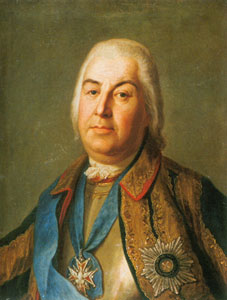
Count Pyotr Semyonovich Saltykov was a Russian statesman and a military officer, promoted to the rank of Field marshal on 18 August 1759.
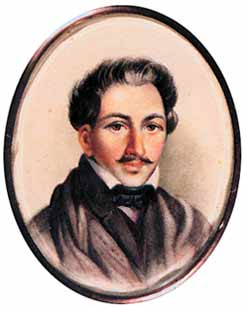
Pyotr Grigoryevich Kakhovsky was a Russian Empire officer and active participant of Decembrist revolt, known for the murder of General Mikhail Miloradovich and Colonel Ludwig Niklaus von Stürler.

Prince Pyotr Andreyevich Vyazemsky was a Russian Imperial poet, a leading personality of the Golden Age of Russian poetry.
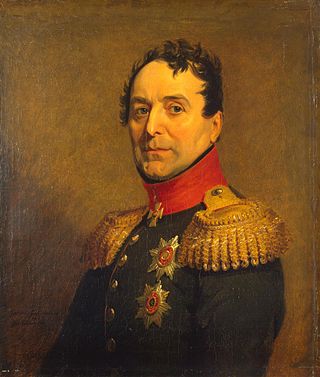
Count Pyotr Aleksandrovich Tolstoy was a Russian general and statesman.

Alexander Semyonovich Shishkov was a Russian writer, literary critic, philologist, memoirist, military and statesman, Admiral (1824). He created a new trend in Russian literature, called "postafactum" [sic], a type of archaism.
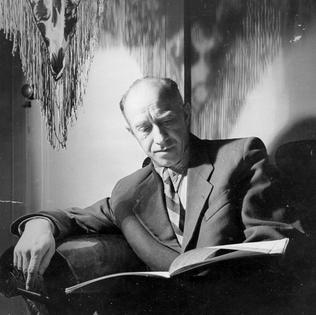
Pyotr Andreyevich Gusev was a ballet dancer, teacher and choreographer. He was born on 29 December, 1904 in St. Petersburg. He studied at the St. Petersburg School of Choreography under Alexandr Shiryayev. He was a friend of George Balanchine and joined his Young Ballet group. He graduated in 1924 and joined the Kirov Ballet. He married Olga Mungalova, a ballet dancer at Kriov. In 1935 he left the Kirov and joined the Bolshoy in Moscow as a soloist. He was dancing with such ballerinas as Galina Ulanova and Maya Plisetskaya.
Alexander Vasilievich Kikin was a political mentor and advisor to Alexei Petrovich, Tsarevich of Russia; accused of having arranged the flight abroad of the latter, Kikin was broken on the wheel.

Count Pyotr Andreevich Kleinmichel, also known by German name Peter von Kleinmichel, was Minister of Transport of Imperial Russia (1842–1855).

Pyotr Vasilievich Basin was a Russian religious, history and portrait painter. He also served as a Professor at the Imperial Academy of Arts.
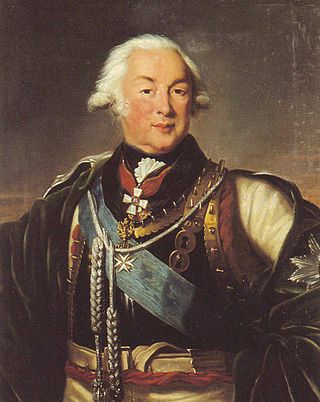
Count Ivan Petrovich Saltykov was a Russian Field Marshal, the Governor-General of Moscow from 1797 to 1804, and owner of the grand estate of Marfino.

The Imperial Society for the Encouragement of the Arts was an organization devoted to promoting the arts that existed in Saint Petersburg from 1820 to 1929. It was the oldest society of its kind in Russia. Until 1882 it was called the "Society for the Encouragement of Artists". After 1917, it became the "All-Russian Society for the Encouragement of the Arts".

Pyotr Andreyevich Karatygin was a Russian dramatist and actor. The tragic actor Vasily Karatygin (1802-1853) was his brother.
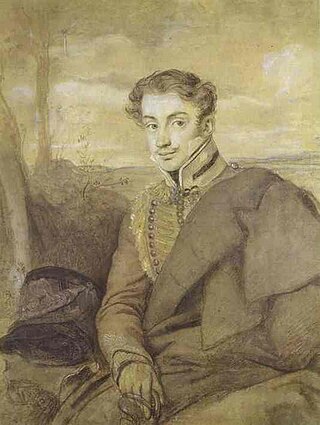
Alexander Ivanovich Dmitriev-Mamonov was the commander of a Belarusian Hussar regiment and a battle painter.

Dmitry Vasilyevich Dashkov was a Russian statesman and writer. For the last ten years of his life, he headed the Ministry of Justice as minister. He was a founder of the Arzamas literary society.

Pyotr Andreyevich Gnido was a Soviet fighter pilot during World War II who was credited with 34 solo and 6 shared aerial victories, and recipient of the title of Hero of the Soviet Union.